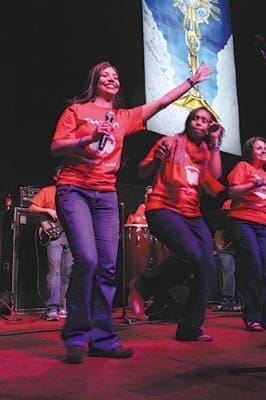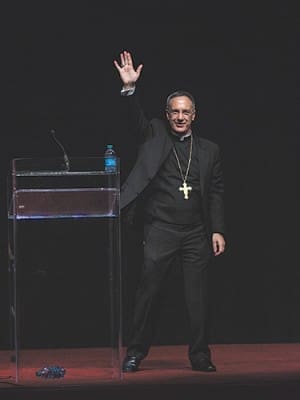 Photo by Michael Alexander
Photo by Michael AlexanderCollege Park
Our Lady Of Guadalupe Shines At Hispanic Track
By RUTH E. DÁVILA, Special To The Bulletin | Published June 6, 2013
COLLEGE PARK—Our Lady of Guadalupe was an ever-present mother at the Spanish track of the Eucharistic Congress June 1. Her image sat, framed, as a centerpiece onstage. Signage and books bore her likeness. And her form was stitched into apparel and accessories across a crowd of thousands—from T-shirts to jewelry to starched dress shirts.

Msgr. Eduardo Chavez, a priest from the Archdiocese of Mexico, speaks in the Spanish track. He is the founder and first rector of the Institute of Guadalupan Studies. Photo By Thomas Spink/Archdiocese of Atlanta
Nowhere was “La Virgencita” more alive than within the talk of the culminating speaker, Father Eduardo Chávez. He is the founder and director of the Mexico City-based Higher Institute of Guadalupan Studies (Instituto Superior de Estudios Guadalupanos).
Father Chávez and his colleagues preserve a body of work about the apparition, promote scientific facts and debunk myths about the image, and spread its message throughout the global Church. He gave a supercharged talk that packed the auditorium and captivated attendees.
Like a majority of Atlanta’s Hispanic population, Father Chávez was born and raised in Mexico—where “Santa María de Guadalupe” might as well be the national emblem, arguably reproduced in arts, handcrafts and clothing as much as the Mexican flag.
Shortly after Father Chávez launched his talk, he asked how many women in the audience were named María. Section by section, dozens of hands shot up.
“Maria means God’s chosen one, the illuminator, the most beloved, the most beautiful,” Father Chávez said. It is the loveliest name on earth, he added. An important distinction, he noted, is that Mary—in all her apparitions—comes not as the light but as the one who illuminates, pointing to her son Jesus. This sentiment was captured in her famous biblical words representing the congress’s theme: “Do Whatever He Tells You.”
Father Chávez has built his institute on the grounds that “La Virgen de Guadalupe” is more than a saint, an icon or a cultural phenomenon. She is the object of devotion that brings people from all walks of life to their knees—literally. The Basilica of Our Lady of Guadalupe in Mexico City, where the original image resides, generates more Catholic tourism than any other site, including the Vatican, Fatima (Portugal) and Lourdes (France), Father Chávez said.

A music group from St. John Neumann Church, Lilburn, leads the praise and worship in the Spanish track. Photo By Michael Alexander
Flashing images on the screen, Father Chávez spoke of pilgrims, both semi and fully prostrate, who inch their way humbly toward the entrance in veneration. In one photograph he shared, a father crawls on hands and knees, with his toddler daughter following in the same fashion a couple of meters behind.
Inside the basilica, the “tilma” where her image appears, a fabric woven of agave (cactus plant) fibers, is in mint condition. It was preserved even after spending its first 116 years with no protection at all. Typically, that material would have deteriorated in eight to 10 years, Father Chávez said.
‘Inculturation’ Of The Gospel
It is not only natives of Mexico who seek Our Lady of Guadalupe’s intercession. In an impressive torrent of photographs taken from all reaches of the earth, Father Chávez shared the many cities, nations and cultures where Our Lady of Guadalupe has found a strong following. Families, workers and world leaders have visited her. Father Chávez spoke of Vice President Joe Biden’s visit to Mexico City in May 2012. Biden made a special request to visit the basilica. His mother, deceased, had been a great devotee. Kneeling before the image, he buried his head in his hands and broke into uncontrollable tears. After several minutes of reflection, Biden rose and said, “My only regret is that she’s not here,” Father Chávez recalled.
As the official patroness of the Americas, sanctuaries in her honor are sprinkled from Alaska to Argentina. Yet people of different tongues and different times have claimed her as their own from France to Mozambique, India to Italy, Vietnam to the highest peak of the Himalayas.
Father Chávez signaled the image’s disparate representations worldwide, reflecting a variety of cultures and skin tones. The localization of Our Lady of Guadalupe is an extension of what Father Chávez calls the “‘inculturation’ of the Gospel”: her ability to penetrate hearts near and far, leading them to Scripture in a way that speaks to them uniquely and intimately.
Our Lady of Guadalupe is, at heart, a truly universal mother. Her “mestizo” physical features denote a mixture of indigenous, Spanish and Arabic (from years of Moorish rule in Spain) and other ethnic roots, Father Chávez noted. The word “Guadalupe,” Chávez explained, was brought into the Spanish language by way of Arabic.

Bishop Luis R. Zarama lifts his hand to the applause from the Spanish track crowd. Photo By Thomas Spink/Archdiocese of Atlanta
The tie to indigenous history bears mentioning. Our Lady of Guadalupe appeared to Juan Diego 10 years after the Spanish conquest, during the Aztec empire: Dec. 9-12, 1531. The Aztecs—who had a foothold ranging from present-day central Mexico to Guatemala, El Salvador and Honduras—practiced human sacrifice ritualistically. Children as young as 4 years old were offered by their parents as living sacrifices. In a public ceremony, priests would cut open the victims’ chests and pull out their beating heart as an offering to the gods to perpetuate the cycle of the sun.
Juan Diego was of the Tolteca tribe, one of the only monotheistic groups in the region. He encountered Our Lady on the hilltop of Tepeyac (giving birth to another of her names, “La Virgen de Tepeyac”). Juan Diego had been crying out to God in despair, distraught by his uncle’s illness, Father Chávez described. Our Lady addressed him in his native Nahuatl: “I am the mother of Netzahualcóyotl (the name his people used to refer to God). I want a sacred house to offer my ‘person love.’”
The “person love,” he explained, is Jesus—the ultimate human sacrifice embodied.
“It was as though she were saying: the real God is not distant. He has not abandoned you. He wants to come live with you,” Father Chávez exclaimed.
He adds, “It was as though she were saying: no more human sacrifice.” While scholars have debated the motives behind the termination of the Aztec sacrifice ritual, Father Chávez and many Catholics believe that it was primarily Our Lady of Guadalupe’s message and intercession that not only stopped the practice, but also led to the conversion of millions in the region and a stronghold of Catholic culture that remains today.
Her message still rings true, Father Chávez said. The key is to recognize that Our Lady is a powerful path to a luminous end.
For more information about the Instituto Superior de Estudios Guadalupanos and Father Eduardo Chávez, visit www.iseg.org.mx.